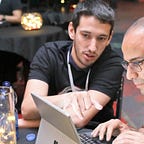Installing Azure ML Estimator Dependencies from Remote GitHub Branches
TLDR; The Azure ML (AML) Service Estimators make it easy to train distributed machine learning models at scale. This post outlines how to configure external AML estimator dependencies from GitHub.
What is Azure ML and Why Should I Care?
The Azure Machine Learning Service provides several ways to train machine learning models, from code first solutions using the SDK to low code solutions such as AutoML and the Visual Designer.
To learn more check out the documentation.
If you don’t have an Azure Subscription you can get a free one using the link below.
With the subscription you can get started learning the ins and outs of the Azure Machine Learning service with the following Microsoft Learn Path.
What is an Azure ML Estimator?
Azure ML Estimators make it easy to train models based on popular machine learning frameworks. There are estimator classes for Scikit-learn, PyTorch, TensorFlow, and more. There is also a generic estimator that can be used with frameworks that do not already have a dedicated estimator class. You don’t have to worry about defining a run configuration when using estimators.
To get started with the default Azure ML Estimators check out the link below.
How to Configure Estimator Dependencies from GitHub?
Estimators provide the ability to add package dependencies from PyPI and Conda however not all the software dependencies are available in these repositories and sometimes ML engineers might want to install from source.
The following code shows how to install from a remote github package using the nlp-architect and the absa branch as an example.
Now you can get started creating custom Azure ML estimators for your open source GitHub projects without the need to write a custom run configuration or create a docker environment.
Next Steps
Now that you know how to configure dependencies from GitHub check out my previous post on 9 Advanced Tips for Production machine learning and how to get started with Azure Notebook VMs.
If AI/ML interests you check out these amazing open source best practice repos as well.
About the Author
Aaron (Ari) Bornstein is an avid AI enthusiast with a passion for history, engaging with new technologies and computational medicine. As an Open Source Engineer at Microsoft’s Cloud Developer Advocacy team, he collaborates with Israeli Hi-Tech Community, to solve real world problems with game changing technologies that are then documented, open sourced, and shared with the rest of the world.
